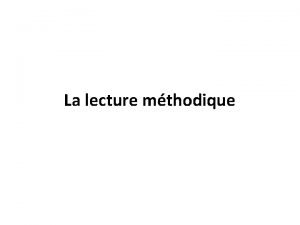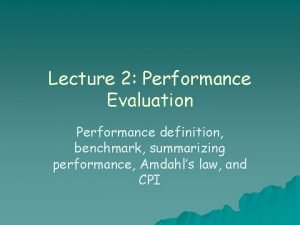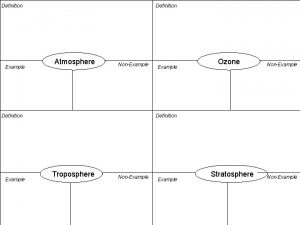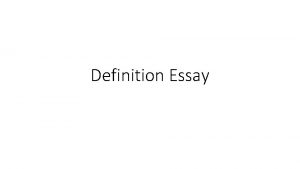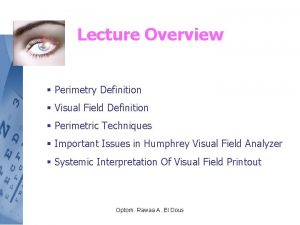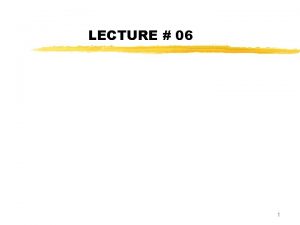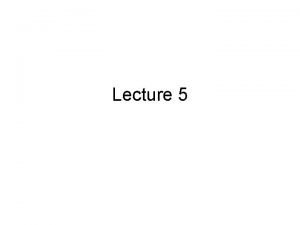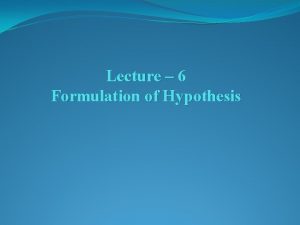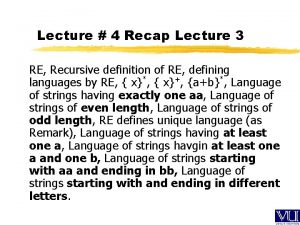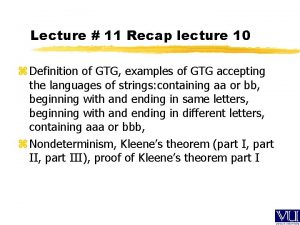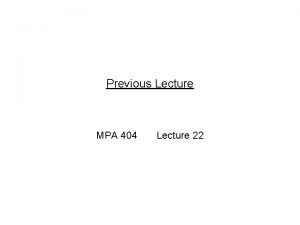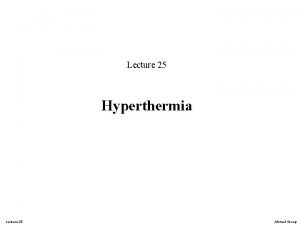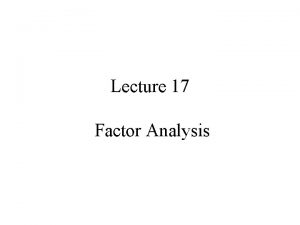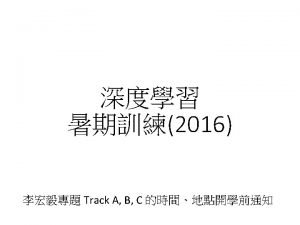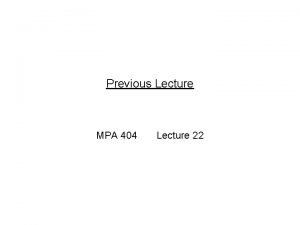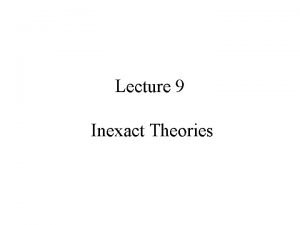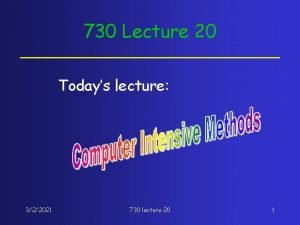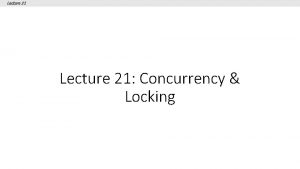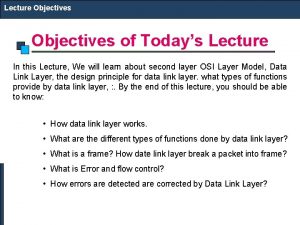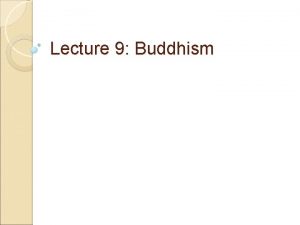LECTURE 06 1 Definition of TG Definition A




























- Slides: 28

LECTURE # 06 1

Definition of TG Definition: A Transition graph (TG), is a collection of the followings 1)Finite number of states, at least one of which is start state and some (maybe none) final states. 2)Finite set of input letters (Σ) from which input strings are formed. 3)Finite set of transitions that show to go from one state to another based on reading specified substrings of input letters, possibly even the null string (Λ). 2

Note z It is to be noted that in TG there may exist more than one paths for certain string, while there may not exist any path for certain string as well. If there exists at least one path for a certain string, starting from initial state and ending in a final state, the string is supposed to be accepted by the TG, otherwise the string is supposed to be rejected. Obviously collection of accepted strings is the language accepted by the TG. 3

Example z Consider the Language L , defined over Σ = {a, b} of all strings including Λ. The language L may be accepted by the following TG a, b Λ + The language L may also be accepted by the following TG 4

Example Continued … TG 1 a, b TG 2 a, b + 5

Example z Consider the following TGs TG 1 - TG 2 a, b - 1 a, b TG 3 - a, b 1 6

Example Continued … z It may be observed that in the first TG, no transition has been shown. Hence this TG does not accept any string, defined over any alphabet. In TG 2 there are transitions for a and b at initial state but there is no transition at state 1. This TG still does not accept any string. In TG 3 there are transitions at both initial state and state 1, but it does not accept any string. 7

Example Continued … Thus none of TG 1, TG 2 and TG 3 accepts any string, i. e. these TGs accept empty language. It may be noted that TG 1 and TG 2 are TGs but not FA, while TG 3 is both TG and FA as well. It may be noted that every FA is a TG as well, but the converse may not be true, i. e. every TG may not be an FA. 8

Example Consider the language L of strings, defined over Σ={a, b}, starting with b. The language L may be expressed by RE b(a + b)* , may be accepted by the following TG a, b –– b + 9

Example z Consider the language L of strings, defined over Σ={a, b}, not ending in b. The language L may be expressed by RE Λ + (a + b)*a , may be accepted by the following TG a, b –– a + Λ + 10

TASK z Build a TG accepting the language of strings, defined over Σ={a, b}, ending in b. 11

Example Consider the Language L of strings, defined over Σ = {a, b}, containing double a. The language L may be expressed by the following regular expression (a+b)* (aa) (a+b)*. This language may be accepted by the following TG 12

Example Continued … b, a 1 - b, a aa 2+ 13

Example Consider the language L of strings, defined over Σ={a, b}, having double a or double b. The language L can be expressed by RE (a+b)* (aa + bb) (a+b)*. The above language may also be expressed by the following TGs. 14

Example continued … x a a a, b –– + b b y 15

OR a, b - a, b aa, bb + 16

OR a, b 1 - a, b aa a, b 3 - 2+ bb 4+ 17

Note z In the above TG if the states are not labeled then it may not be considered to be a single TG 18

Task Solution z Build a TG accepting the language L of strings, defined over Σ={a, b}, ending in b. z Solution The language L may be expressed by RE (a + b)*b, may be accepted by the following TG a, b –– b + 19

Example Consider the language L of strings, defined over Σ={a, b}, having triple a or triple b. The language L may be expressed by RE (a+b)* (aaa + bbb) (a+b)* This language may be accepted by the following TG 20

Example Continued … 2 a 4 a a, b 6+ 1– b b 3 b 5 21

OR a, b - a, b aaa, bbb + 22

OR a, b 1 - a, b aaa a, b 3 - 2+ bbb 4+ 23

Example Consider the language L of strings, defined over Σ = {a, b}, beginning and ending in different letters. The language L may be expressed by RE a(a + b)*b + b(a + b)*a The language L may be accepted by the following TG 24

Example continued … a, b a 1 b 2 b 4+ a, b 3 a 5+ 25

Example z Consider the Language L of strings of length two or more, defined over Σ = {a, b}, beginning with and ending in same letters. The language L may be expressed by the following regular expression a(a + b)*a + b(a + b)*b This language may be accepted by the following TG 26

Task Build a TG accepting the language L of strings, defined over Σ={a, b}, beginning with and ending in the same letters. 27

Example Continued … a, b a 1 b 2 a 4+ a, b 3 b 5+ 28
 01:640:244 lecture notes - lecture 15: plat, idah, farad
01:640:244 lecture notes - lecture 15: plat, idah, farad Voix haute
Voix haute Lexical expressive means
Lexical expressive means Définition de la lecture méthodique
Définition de la lecture méthodique Definition of teaching method
Definition of teaching method Wbb99
Wbb99 Project procurement management lecture notes
Project procurement management lecture notes Lecture about sport
Lecture about sport Healthy lifestyle wrap up lecture
Healthy lifestyle wrap up lecture Makeup lecture meaning
Makeup lecture meaning Meaning of this
Meaning of this Randy pausch last lecture summary
Randy pausch last lecture summary Tensorflow lecture
Tensorflow lecture Theology proper lecture notes
Theology proper lecture notes Strategic management lecture
Strategic management lecture Geology lecture series
Geology lecture series Social psychology lecture
Social psychology lecture In text citation for a lecture
In text citation for a lecture Definition of public sector accounting
Definition of public sector accounting Construction management lecture notes
Construction management lecture notes Eurocode 2 lap length table
Eurocode 2 lap length table Electricity and magnetism lecture notes
Electricity and magnetism lecture notes Physics 111 lecture notes
Physics 111 lecture notes Physics 101 lecture notes pdf
Physics 101 lecture notes pdf Physical science lecture notes
Physical science lecture notes Power system dynamics and stability lecture notes
Power system dynamics and stability lecture notes Natural language processing nlp - theory lecture
Natural language processing nlp - theory lecture Microbial physiology and metabolism lecture notes
Microbial physiology and metabolism lecture notes Mechatronics lecture notes ppt
Mechatronics lecture notes ppt



